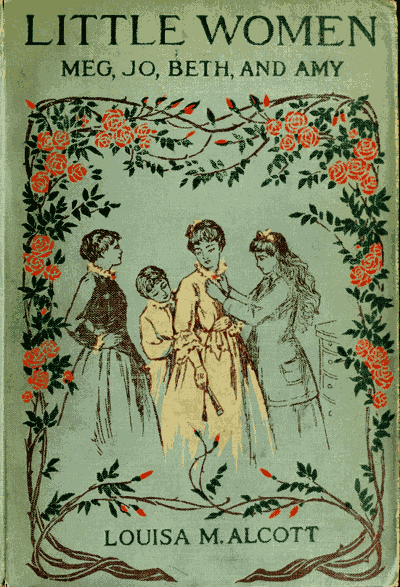I just finished reading Little Women by Louisa May Alcott. I really enjoyed it! The tale of four sisters was both touching and entertaining, a perfect balance of the trial and joys one faces throughout life. The story of Meg, Jo, Beth, and Amy - as well as everyone in between - is one I am pleased to say I shall never forget.
Thomas Foster dedicates the 20th chapter in his book to the meaning and impact of specific seasons. One of the most significant connections I made between Foster's words and Alcott's was just that - the idea of seasons playing a great role in the story. The entire plot of Little Women ties in with the changes throughout time, and what is a great way to show the shifting of that time? The passing of different seasons. They also connect events that take place in the book to specific emotions. As Foster wrote, "Happiness and dissatisfaction have their seasons..., Summer is passion and love; winter, anger and hatred" (Foster 94). At one point in the story, Beth, the more feeble sister who is beloved by all, catches scarlet fever. She gets incredibly sick, and ends up coming to the brink of death. This happens in the heart of winter. By already suggesting struggle and poverty, coldness and fear in the freezing weather, Alcott creates an ominous feel to that part of the book, adding greatly to the overall effect of Beth's illness on the audience.
It works both ways. At the end of the novel, the characters all come together for "Harvest Time" to pick fruit within an apple orchard. The families they have built up and the friendships they have deepened come together in order to rejoice for lives well-lived. There is laughter, smiles, music, and even tears of joy throughout the reunion. Foster explains, "So harvest, and not only of apples, is one element of autumn. When our writers speak of harvests, we know it can refer not only to agricultural but also to personal harvests, the results of our endeavors, whether over the course of a growing season or a life" (Foster 95). Therefore, summer and autumn are used to boost the feeling of happiness and joy for the characters, just as spring is a time of renewal. Throughout the book, many events that spark change take place during spring, directly after the cold snows of winter melt away, paving a way for growth and new opportunities. And as you can see, all four seasons have a certain impact on the story. Winter - death, worry, sadness, fear. Spring - renewal, change. Summer - happiness, joy. Autumn - the harvest, rejoicing over life.
Once one understands the impact of seasons on a plot line, it's easier to understand the overall effect an author intends to make in a work of literature. Most events written into novels were put there for a reason, in a certain spot of time that would make the point the most effective. Writing is perplexing that way, don't you think? :)

I've noticed the prominence of seasons and the weather while reading Jane Austen's *Pride and Prejudice*, as well! Because the story takes place in 19th-century England, the characters' ability to travel is highly dependent on what the weather is doing, and the weather is highly dependent on what season it is. So not only does the weather symbolize things like renewal and fertility or terrible sadness, but it also controls the characters' feelings of independence or isolation, of curiosity or contempt. Elizabeth Bennet often finds herself stuck in one place for weeks at a time as a result of the weather, and it is in the great outdoors that she falls in love with Mr. Darcy. I tend to see the seasons placed in higher regard when reading older works of literature; the books I've read that have been written within the last 10 years surprisingly don't seem to have a lot about what Mother Nature is doing in them. I'm not really sure why that is - maybe it's a result of this generation's renewed affinity for the indoors and concentration on technology. What do you think?
ReplyDeleteI completely agree! As *Little Women* takes place around the time of the Civil War, it supports the idea that the seasons did play a larger role in older books. I mostly read newer novels, but I do read some old ones as well. The newer books, as you said, don't really include the changing of the seasons as much as the older books do. It seems like the stories written today tend to take place within one or two seasons rather than showing the progression of time through the years. It's interesting to see the changes that take place within the characters, but I guess sometimes people don't like time gaps in their story. Well, thanks for the thoughtful comment, Julia! :)
DeleteWhat a great correlation between seasons and overall mood in different parts of the book. Charles Dickens, the author of the first book that I read for our summer assignment, also wrote a book called 'Bleak House' in which a young boy dies of yellow fever in the depths of winter-- a tragic moment in the story that was amplified by the chilliness of the weather. The season almost makes the reader feel more helpless about the death, as the suffering character is confined to a small space indoors where they can only pray that they get better. It's a funny coincidence that the boy who dies in 'Bleak House' is named Jo, which is also the name of one of the characters in 'Little Women.' There truly is no original work of literature!
ReplyDeleteWow! What do you know? That is quite a coincidence! The two Jo's! :) Yes, illness, death, and winter do seem to be associated closely together. The effects of the seasons on a piece of literature are magnificent. Thanks for the comment, Hannah!
Delete